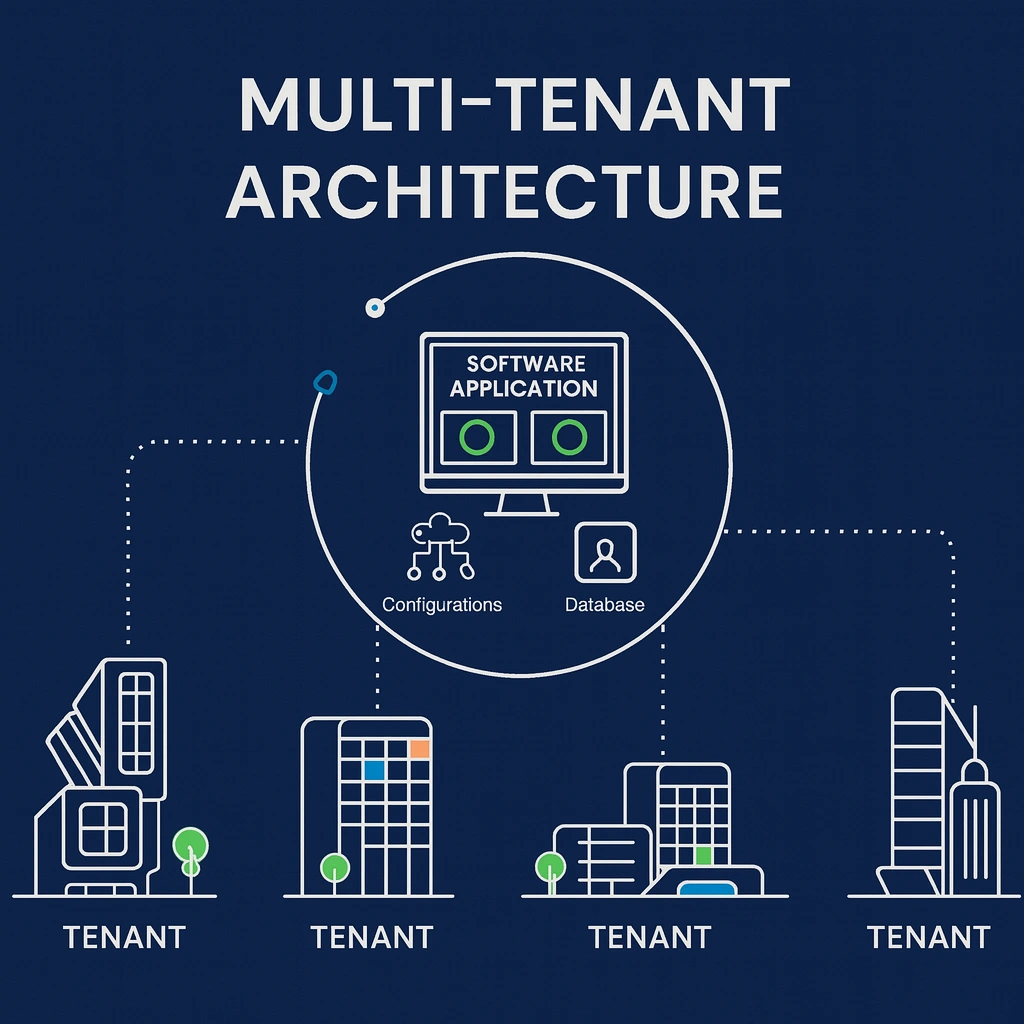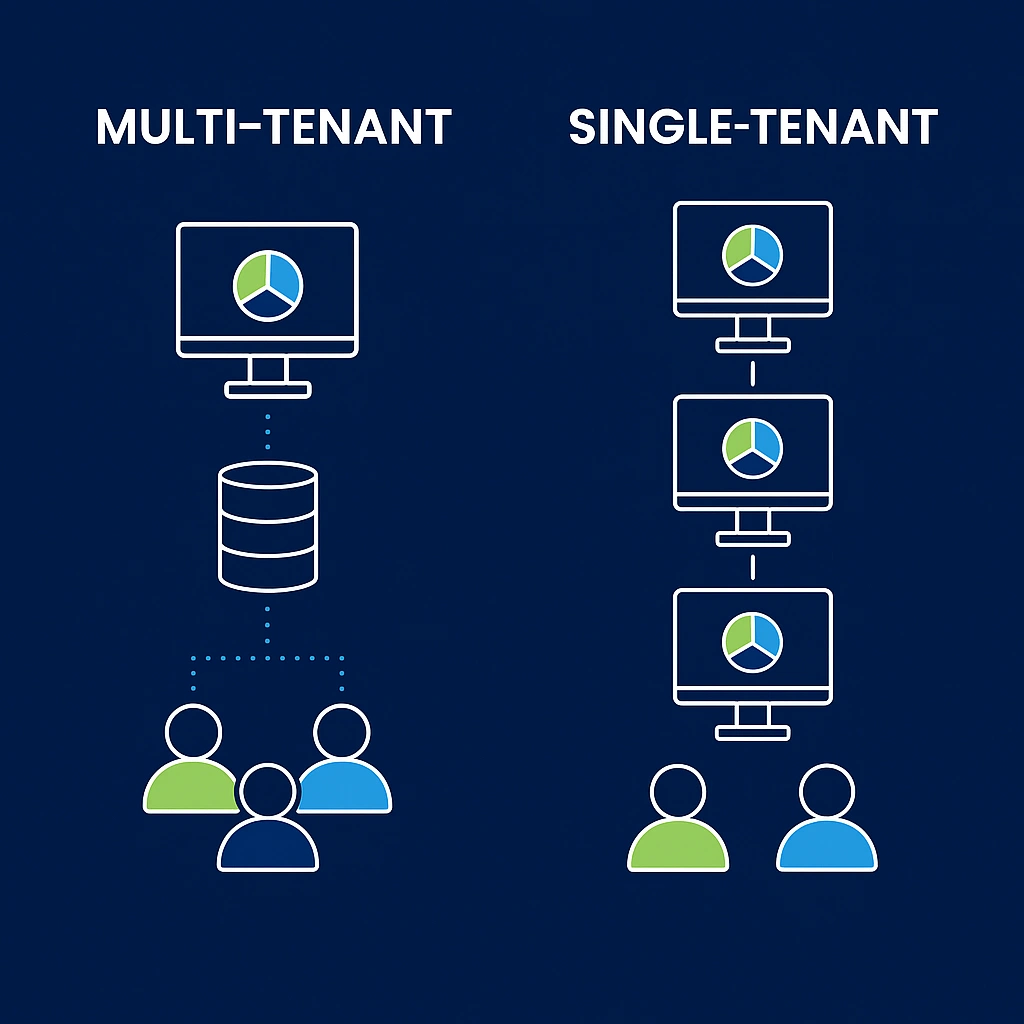Today, when businesses discuss cloud architecture, multi-tenant or multitenancy comes up so frequently that it almost fades into the background.
But behind the scenes, it’s one of the reasons cloud services scale as smoothly as they do, and why SaaS products can serve thousands of customers without spinning up thousands of separate environments.
Multi-tenancy is the foundation that helps companies build, ship, update, and maintain software for a global audience without drowning in operational overhead.
The concept itself is older than most people realize. It didn’t start with AWS or Azure. It didn’t even start with virtualization. It goes back to the days of mainframes — giant machines that entire organizations shared because computing was expensive and efficiency wasn’t optional. That same mindset has carried into modern cloud computing, but with a different level of sophistication.
What makes multi-tenancy interesting today? It’s not just a cost-saving trick or a deployment shortcut. It has turned into a strategic design choice, one that affects scalability, security, performance, operational efficiency, and even regulatory compliance. In other words, the things companies care about long after the software is released.
In this blog post, we will discuss multi-tenancy: what it is, why it’s important, the advantages and disadvantages, how each of the various models works, and what the future of multi-tenancy may look like.
What is Multi-Tenant Architecture?

To strip away the jargon everyone’s heard many times, multi-tenancy is simply the notion that many users are using the same application environment, where each user feels they are using their own individual user experience/system. Their data is separated. Their settings are separated. Their permissions are separated. But behind the scenes, the application and infrastructure are shared.
One of the most accurate analogies is an apartment complex. Everyone has their own space, i.e., their own keys, their own layout, their own privacy, but the building structure, utilities, security system, and maintenance team are shared.
Most multi-tenant applications use a logical separation. That means tenants don’t each run their own server. Instead, the application is designed to understand who a user belongs to, retrieve their data safely, and apply the right policies around it.
This involves a few core mechanisms:
- Tenant-aware authentication so users are recognized as part of the correct tenant.
- Isolated data access so users can only see and interact with their tenant’s data.
- Configurable layers that allow customization without altering the core codebase.
- Shared runtime handling so the application processes requests from many tenants simultaneously.
For a solution consultant, the beauty of multi-tenancy is that it simplifies almost everything downstream. Instead of deploying dozens of customized environments, you’re working with one system that intelligently responds to the needs of each tenant.
Why Multi-Tenancy Became the Norm in Cloud Computing
If you’re designing cloud software today, multi-tenancy is almost the expectation. The shift didn’t happen by accident. It came from a combination of economic pressure, technical evolution, and customer expectations that grew as SaaS took over traditional software licensing.
Multi-tenancy grew primarily for three reasons.
1. Economics changed dramatically
Cloud spending has become one of the biggest line items in tech budgets. According to Flexera’s 2024 State of Cloud report, 84% companies faced challenges in managing their cloud spend. Multi-tenancy helps reduce this waste because more customers share the same infrastructure, achieving higher density with lower idle time.
When you’re running a SaaS platform with tens of thousands of tenants, you can’t afford to dedicate a separate server or application instance to every customer. It’s not financially viable, and most customers aren’t willing to pay for that level of isolation unless they’re in a regulated sector.
2. SaaS adoption forced scalability
As more businesses transitioned to subscription-based software, providers needed a model that enabled them to serve large customer volumes. Multi-tenancy offered the right balance: scalable, cost-effective, and manageable without deploying and updating thousands of copies of the same software.
Gartner has published several papers over the years showing that multi-tenant SaaS solutions reduce operating costs for providers by nearly a third, which is a significant advantage in a competitive software market.
3. Operational simplicity became essential
Imagine a scenario where every customer uses a slightly different version of your application. That’s what single-tenant deployments lead to. You end up stuck maintaining multiple versions, running multiple updates, and handling separate support requests.
With multi-tenancy, your engineering team has a codebase, a deployment pipeline, and a set of updates that instantly apply to all. Salesforce often highlights this benefit publicly — their famous “three updates per year” only works at scale because of their multi-tenant architecture.
So multi-tenancy isn’t just a technical pattern. It’s a strategic one that helps organizations scale wisely instead of scaling their way into a maintenance nightmare.
Different Types of Multi-Tenant Architecture
Instead of diving into diagrams or overly technical explanations, here’s how these multi-tenant models work in real-world terms.
Single Application With Single Database (Shared Schema)
This is the most straightforward version of multi-tenancy. All tenants share one application instance and one database schema. Their records are separated by a tenant identifier, but physically, it’s the same storage engine underneath.
This approach is ideal for early-stage SaaS products or businesses that want to keep the infrastructure footprint lean. The simplicity makes scaling easier, and costs stay low because you don’t have to maintain multiple databases.
The main drawback is performance predictability. If a single tenant starts running heavy workloads—say, an unusually large report—the load might cause slowdowns for everyone else. It’s like living in an apartment building where someone suddenly starts using all the hot water.
Companies that use this model rely heavily on intelligent caching, rate limiting, and load balancing to keep the experience smooth across tenants.
Single Application With Multiple Databases
This version strikes a balance between efficiency and isolation. The application is shared, but each tenant gets its own database. That means data is physically separated, but operationally, the application remains unified.
This is common when tenants operate under different regulatory environments. For example, if one tenant requires that data remain in Europe because of GDPR and another must keep data in the United States due to contractual obligations, separate databases allow that flexibility.
However, this approach increases maintenance. The more tenants you have, the more databases you’re responsible for. Backups, indexing, migrations, failovers — everything becomes a multi-database activity. Organizations often adopt automation tools to manage these databases consistently.
Multiple Applications With Multiple Databases
This is the highest-isolation model. Each tenant gets its own application environment and its own database. It’s technically multi-tenant from a provider perspective, but operationally, tenants are isolated to the point that their environments function almost like independent deployments.
This setup is typical for customers in sectors like finance, healthcare, defense, or government, where isolation, compliance, and data sovereignty are non-negotiable. The environments behave like single-tenant systems, but providers still orchestrate them using automated deployment tools and containerized infrastructure.
The advantage is extremely strong isolation. The challenge is cost and operational overhead. You need disciplined DevOps processes and strict configuration management to prevent version drift.
Advantages of Multi-Tenancy Architecture
It’s easy to see why multi-tenancy has become so widely adopted. When designed well, it delivers benefits that impact engineering teams, financial teams, and customers simultaneously.
One of the biggest advantages is cost efficiency. Running a unified system is naturally less expensive. According to a ResearchGate case study, multi-tenant SaaS architectures can reduce operational expenses by up to 40% through enhanced regulatory compliance and AI governance, largely because shared infrastructure and streamlined maintenance can reduce overhead.
Another major advantage is consistent updates. When a provider patches the application or releases a new feature, it goes out once, and everyone receives it instantly. That eliminates the headaches associated with maintaining multiple application versions.
Scalability is also far easier with multi-tenancy. Instead of scaling dozens of tenant-specific applications, you scale one environment horizontally. Adding more compute, increasing database throughput, or introducing additional nodes becomes a centralized effort.
And finally, the administrative load becomes smaller. Providers monitor one system, not hundreds. They have one logging pipeline, one backup strategy, one deployment flow, and one security configuration to maintain. The streamlined approach reduces risk and accelerates development cycles.
Disadvantages of Multi-Tenancy and How Modern Architecture Solves Them
As helpful as multi-tenancy is, it comes with some real challenges. However, these challenges aren’t showstoppers. Over the years, cloud providers and engineering teams have developed reliable techniques to address them.
One commonly mentioned drawback is reduced flexibility. Tenants often want specific custom behaviors that can’t be supported without modifying the application itself. Multi-tenant systems are intentionally restrictive to keep the core codebase consistent. Providers work around this by designing configuration layers, feature flag systems, and plugin-style extensions that give tenants room to shape the application without jeopardizing stability.
Security is another area where people express concern. With multiple tenants sharing the same system, isolation must be airtight. That has led to the rise of row-level security rules, schema-level isolation, strict identity controls, and zero-trust architectures. Modern frameworks and cloud providers include tenant isolation as a built-in concept.
Performance interference used to be a significant issue when multi-tenancy was more primitive. Today, platforms like Kubernetes support resource quotas, limit ranges, and quality-of-service classes that tightly control how much CPU or memory a tenant can consume. Auto-scaling mechanisms further reduce the likelihood that one tenant’s activity disrupts others.
The last drawback is downtime risk. A shared system means a faulty update could impact all tenants at once. This is why many organizations use deployment techniques such as canary releases, blue-green deployments, and automatic rollbacks. The goal is to reduce the blast radius of any deployment issues.
Real-World Examples Across Cloud Environments
If you look closely, you’ll see multi-tenancy everywhere in cloud architecture.
Virtual machines and containers are multi-tenant environments by design. A single host machine might run dozens of virtual machines or hundreds of containers. Each one belongs to a different service, department, or customer, but they’re all using the same underlying hardware. This is one of the core ideas behind modern cloud services.
Public cloud providers take multi-tenancy even further. AWS, Google Cloud, and Azure manage massive, shared infrastructure environments where the same physical machines support countless customers. Even the services that feel dedicated often run in multi-tenant compute clusters with strong logical isolation.
SaaS products like Salesforce, HubSpot, and Zendesk are classic examples of multi-tenancy. Salesforce openly attributes its ability to deliver frequent platform-wide updates to its multi-tenant design. HubSpot follows a similar approach, where data is partitioned per customer, but the application experience is shared.
Serverless computing — such as AWS Lambda — is arguably the purest form of multi-tenancy today. When you deploy a function, you don’t know where it runs or what machine it lands on. Your code may run next to another company’s function 100 milliseconds later. Yet isolation ensures one customer can’t affect another.
Multi-Tenant vs Single-Tenant: Which One to Choose

The decision between multi-tenant and single-tenant architecture often comes down to the customer’s needs rather than the provider’s preferences.
Multi-tenancy works best when organizations want predictable costs, easy scaling, and minimal management overhead. According to Deloitte, 84% of companies say multi-cloud will create scalability for data and app processing, while 78% said it will enhance data interoperability.
Single-tenancy, in contrast, appeals to organizations that prioritize customization, strict regulatory isolation, or unique runtime requirements. A single-tenant setup gives them the freedom to modify the environment more deeply and run workloads that would be impractical or risky in a shared system.
There’s no universally better option. Each model has its place. As a consultant, you look at the client’s industry, regulatory obligations, performance expectations, and operational capacity before making a recommendation.
What is the Future of Multi-Tenant Architecture?
If the last decade was about perfecting multi-tenancy for basic SaaS and cloud services, the next decade is about refining it for intelligence, automation, and distributed computing.
One major trend is AI-driven scaling. Cloud providers are starting to incorporate machine learning models that predict usage patterns, automatically rebalance workloads, and reduce resource waste — all of which strengthen multi-tenant systems.
Another trend is policy-based isolation. Instead of relying purely on schemas or physical separation, platforms are beginning to use rule engines — such as Open Policy Agent (OPA) — that create dynamic isolation based on context. This allows more tailored control over who can access what, without needing separate physical databases.
Edge computing is also reshaping how multi-tenancy works. As applications move closer to users for lower latency, providers must determine how to maintain tenant isolation across distributed edge devices and micro data centers.
And microservices continue to evolve multi-tenancy at the service level. Instead of one monolithic application handling everything, services become tenant-aware individually, enabling more fine-grained scaling and improved resiliency.
How Sthenos Can Help
At Sthenos, our cloud consultants spend time digging into how your product works day to day: what’s slowing you down, what your customers keep asking for, and where the current setup is holding you back. The goal isn’t to push a particular model, but to understand the reality you’re operating in and then shape the right approach around it.
What companies appreciate about Sthenos is its ability to balance engineering with practicality. They help you design tenant-aware data models, set up identity frameworks, plan isolation boundaries, and build a deployment pipeline that keeps your system consistent as you onboard more customers. They also guide you through cost modeling and scaling strategies so you understand what your architecture will look like six months from now — not just on launch day.
Sthenos is there to assist you through the entire process of cloud journeys. We handle the strategic plan, platform selection, and secure implementation, so you can get the best return on your cloud investment. Services span from Cloud Consulting, Cloud Migration (Google, Azure, and AWS), Cloud Security, Cloud Optimization, and Cloud DevOps.
If you would like to discuss your objectives or learn how multi-tenancy might fit into your roadmap, you can request a free consultation call with the team.
Final Thoughts
Multi-tenancy extends beyond simply being a style of architecture. It is also the quiet engine that drives the current cloud ecosystem, enabling software providers to reach and scale to thousands of customers without multiplying their operational burden. It helps organizations lower their costs, increase their efficiencies, and maintain an agile response to rapidly evolving market realities.
It is a complex architecture that has evolved, and the industry now has ample options to address some of the associated problems, such as noisy neighbors, tenant isolation, and regulatory pressure.
Whether you are designing a SaaS platform, modernizing legacy applications, or implementing a cloud migration plan, an understanding of multi-tenancy has become mandatory. It is, after all, the lens through which most cloud-native systems are constructed.
As complex as the architecture has become, the basic premise remains the same: a shared infrastructure with intelligent isolation will carry software further than isolated systems ever could – and this is not likely to change as new patterns, new security frameworks, and new automation tools emerge.


